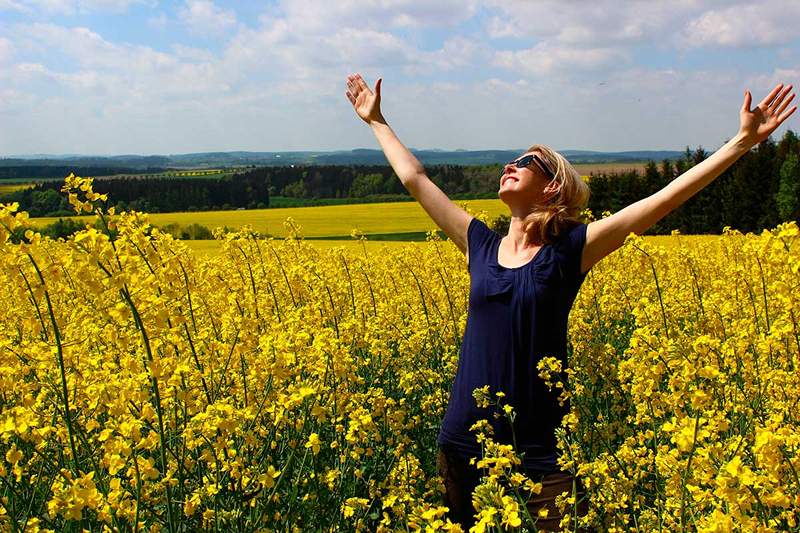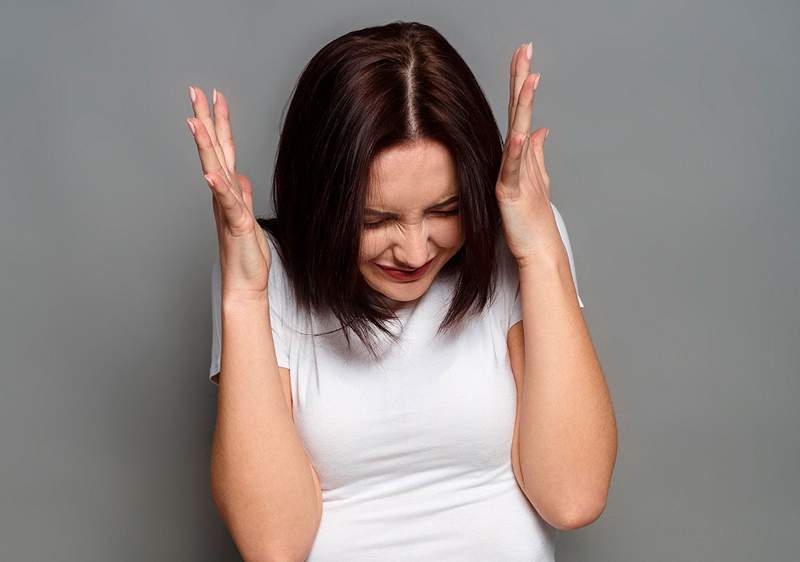Cherophobia fear or phobia of happiness

- 1575
- 319
- Herbert Ritchie
When you are happy, you enjoy music. But, when you are sad, you understand the lyrics. Anonymous
The concept of happiness is like the Holy Grail in the modern era. Sometimes material or sometimes immaterial, it takes as many faces as faces are on this planet Earth.
We deliberately combined happiness to many of our behaviors in everyday life: In kisses, work, in making love, in children, the purchase of a good, the achievement of a goal, the conquest of a lost cause, in health, spiritual or socio-economic well-being, in passing of uncertainty to certainty and in many other aspects.
The Eastern cultures find happiness in inner peace.
This reflection does not intend to reach a unique and universal definition of the concept of happiness. Nor does he intend to write the analysis criteria regarding the concept of cherophobia or irrational fear towards happiness.
On the one hand, there are many definitions about happiness, as we can see below:
Content
Toggle- Definitions of happiness
- What happens when someone is different and does not seek happiness?
- Analyzing the emotion of fear
- Most common fears we face
- Defining fear
- There are fears related to losses
- Other fears are related to social interaction
- Some characteristics about emotions
- Emotions have three components:
- Journey
- Defining happiness
- What is Cherophobia?
- Etiology
- Diagnosis
- Treatment
- SUGGESTIONS FOR CHANGE
- Bibliography
Definitions of happiness
Mood of the cheerful person and satisfied with the situation he lives. Thing that produces this mood: "Having you by my side is my greatest happiness" (Larousse, 2003).
It is the mood that is pleased in the possession of a good (Potes, 2013).
Buddhists conceive happiness based on 5 principles: 1) Accept and appreciate change is fundamental, 2) to worry is absolutely useless, 3) The root of all suffering is the obsession with ephemeral feelings, 4) we must see and understand the reality for what it really is, and 5) meditation is a very powerful means to avoid suffering.
Happiness depends on ourselves. Aristotle (384 to 322 A. C.).
I never thought that happiness had so much sadness. Mario Benedetti; 1920-2009. Poet, playwright and Uruguayan journalist.
For the anthropologist Marc Age, in his book, why do we live?, defines it as the absence of unhappiness (Potes, 2013).
Emotional Welfare State. Satisfaction, fullness, harmony. Experience and experience of positive emotions. Absence of fear (Punset et al, 2018).
By way of summary, under these definitions, happiness: they are moods, feelings, well -being, balance, detachment, inner peace and thanks. Mediated many times for money and related to consumption and pleasure. However, in one way or another, in a rational or emotional way, we seek happiness almost automatically.
What happens when someone is different and does not seek happiness?
In the first instance and only as a pedagogical resource, when someone has a different behavior and is considered to have a disease, it meets at least one of the following four criteria (Halguin & Krauss, 2004):
- Disturbance: After experiencing a painful or traumatic event, experiences physical or emotional pain and costs him a job to carry out his simplest and daily activities.
- Deterioration: One thing can lead to another, and having a disturbed state can create deterioration of cognitive, social and health skills in general. And, a real failure in social interaction (school, work and family).
- Risk for others and for oneself: People can present a risk for themselves and for others. Potentially it could trigger an aggression (suicide or homicide).
- Unacceptable social and cultural behavior: Behaviors outside social norms and reference culture are presented.
 Gratitude: a door to positive thinking and sensations of well -being
Gratitude: a door to positive thinking and sensations of well -being Analyzing the emotion of fear
There are social events that generate a certain discomfort: They go from anxiety, a state of aversion, can rise to fear and even become a phobia or irrational fear.
Some behaviors that in general generate a anxiety to most are: present an exam, have a job interview, a sports competition, the first sexual relationship, speak in public, the visit with a health specialist, have a burden of work that exceeds our abilities and more.
Then then Fear and anxiety sometimes are confused or used as synonyms and are not.

Anxiety is a global and oriented response towards the future, which implies cognitive and emotional components, in which the individual is unusually apprehensive, tense and uncomfortable due to the possibility of something terrible happens. Fear refers to an innate, biological -based alarm response, given a dangerous situation or threatens life (Halguin & Krauss, 2004).
While anxiety generates an anxiety or discomfort for the future, fear lives in the depths of our DNA And it connects us with innate experiences and with past traumatic experiences. In general, all emotions have an imprint, that is, a sensory seal (view, ear, taste, touch and smell) associated with life experiences and related to an emotion. That is why some people have indelible memories in the positive (the first kiss or wedding day) and in the negative (the smell of a hospital or the morgue).
Fear allows us to survive and get away from dangers, but can also ruin our lives. It is possibly the most powerful human emotion. We can detect our own fears doing an introspective exercise every time we have experienced a state of: alarm, alert, fright, phobia, horror, panic, shock, dread, terror or fear.
In this way it is present in each of our decisions that we make in everyday life and direct our lives.
If it exceeds certain limits, it harms us or If our brain interprets reality in an exaggerated way, it incapacitates us and becomes a phobia. If for some reason we associate fear: to specific events or contexts, animals or specific situations, although these are not threatening will create an aversion being able to form a phobia. They activate our past experiences and the degree of discomfort that we can experience in the future, even in the case of really innocuous events such as: Leaving home alone, seeing a dog or climbing a plane.
We believe that the consciousness is what rules, but in reality we are guided at all times by our emotions and they are the ones that win.
Today we know that fear exceeds reason. A simple, but very complex explanation is that when a person feels vulnerable, he feels uncertainty, aversion, fear or fear. And, that is why we are not facing an event that really endangers our life, emotion reacts much faster and we can rarely control this condition with reason.
Most common fears we face
Some fears we face as human beings intend to be safe from death and are essential for basic survival. Others are learned when they are associated with a stimulus that Behavioral psychologists call: neutral stimuli. For example, listening to the sound of the seismic alert in Mexico City, generates us: stress, anxiety, uncertainty, aversion, fear and in some cases panic attacks.
And, others can invest the logic of everyday life by paradoxical that seems. For example, "if I effort me to have a university degree, but just on my graduation the most beloved relative dies," it is impossible not to associate a positive event with a negative one.
Even if this happens again, "I achieve another university degree, but just the same day, I receive the divorce demand from my partner”, The story is repeated, a positive event brings a negative one associated. Bliss association creates a negative reality. The consequence: "I am afraid of being happy, because having a positive experience brings me as an invoice to go through another negative experience in my life ".
Defining fear
Fear, according to DRAE, “is that Angustious disturbance of mood for a real or imaginary risk or damage”And it is a common feeling to all human beings (Ramos, 2015).
Fear: Emotion that It is experienced before a real or imminent danger that you live as overwhelming and that puts health and life at risk (Punset et al, 2018).
Fear: Intense emotion activated by the detection of a imminent threat, Involve an immediate alarm reaction that mobilizes the body by generating a set of physiological changes. These changes include a rapid heartbeat, redirection of the blood flow of the periphery towards the viscera, voltage in the muscles and the general mobilization of the organism to take action. According to some theorists, fear differs from anxiety in the fact that it has an object (p. eg., An predator, financial ruin) and is a proportional response to the objective threat, while anxiety usually lacks an object or is a more intense response that justifies the perceived threat (APA, 2010).
There are fears related to losses
- Fear losing a loved one
- Fear of losing a couple
- Fear of losing autonomy
- Fear of losing health
- Fear of losing some part of the body
- Fear of losing economic and financial status
- Fear of losing life or fear of death
Other fears are related to social interaction
- Fear of not being loved
- Fear to loneliness
- Fear that our ego will be injured
- Fear of compromise
- Fear to fail
- Fear of being
 How to become your best friend
How to become your best friend Some characteristics about emotions
Emotions can come from inside or outside.
Emotions have three ways to experience:
- We keep them and shut up (implosion). If this happens they cause us a disease by somatizing it.
- We leave them free and exploit. If this happens we cause us problems related to violence and aggression.
- We manage them. It is the least common, but it is the healthiest.
Emotions have three components:
- Behavioral: It is the behavior itself that we show.
- Cognitive: This is what we express fundamentally with the face (smile, crying, surprise, joy, anger) is the part that we can have awareness of the emotions we experience and we can give them a name. If we give them a very particular name we can be aware of them and regulate them.
- Neurophysiological: It is the internal body response (sweating, tachycardia, tremor in the legs, are hormonal and neurotransmitter secretions). They reflect our interoception or reality that we live internally.
They are the identity card of our personality.
Even the way to experience them are part of our identity, They guide our decision making, they inform us of the present, they realize how we have experienced the past (fears) and predict our future behavior (anxiety).
The way we live them tells us very precisely about our state of health or disease.
Journey
What makes you happy reader friend? There are people who make up with little and do not need great luxuries to experience a pleasant state of tranquility and relaxation. In the uniqueness of each human being, there are things that They make us happy to each other not so much. They are related to experimenting or feeling: banal, simple, fun states that provide us with some peace or stillness.
Among them are:
- Contact with nature
- Eat the favorite saucer
- Make love and share love with loved ones
- Mitigate thirst or hunger
- Write poetry, jokes, scientific articles or absurd things
- Get distracted with social networks
- Go to the cinema, one day or play
- Go on vacation without worries
- Feel in love
- Create, write or just listen to music
- The smells that remind us of wonderful moments
- Take or see photographs
- The feeling of taking a nice bath
- A deserved rest
- Sleep healthily or even dream awake
- The heat of the home or of the loved people
- Sing and dance
- Contemplate the sunrise, noon, dusk
- Feel the wind on the face
- Receive blessings or congratulations from your own or strangers
- Achieve economic security
- Buy goods
- Prepare a rich food and share it with other people
- Meditate, practice yoga, pray and feel in peace
- Feel the joy of living and enjoying life
Anyway, the list seems almost endless fortunately.

Eduard Punset (2018) in his Emotions Dictionary, distinguishes more than forty states or ways to feel happy. In their metonymy we can distinguish some of them: peaceful, harmony, well -being in general, emotional well -being, professional well -being, hedonic well -being, psychological well -being, social well -being, subjective well -being, calm, bliss, equanimity, balance, flow, glory, joy, mindfulness , inner peace, placidity, plenitude, relaxation, satisfaction, serenity, calm and tranquility.
Defining happiness
Happiness is an inner task and each person is different in living, enjoying it and creating it. Only as a reference is a couple of definitions without the desire to choose a unique and regulated form.
It is the state of emotional well -being. Satisfaction, fullness, harmony. Experience and experience of positive emotions. Absence of fear (Punset et al, 2018).
Happiness: Mood of the cheerful person and satisfied with the situation in which he lives. Thing that produces that mood: having you by my side is my greatest happiness (Larousse, 2003).
 What is Tripophobia? Symptoms, causes and treatments
What is Tripophobia? Symptoms, causes and treatments What is Cherophobia?
By paradoxical that seems to be the phobia to be happy. Going through all its nuances: Fear, aversion or uncertainty to be happy. And, the person with Cherophobia will avoid linked to facts, events, situations or experiences related to living or experiencing their own happiness.
PEOPLE WITH CHEROFOBIA They want to get away from what makes them feel happy (Torres, 2018). It does not mean that they flee deliberately to happiness or what makes them feel good, but try to put a distance.
Etiology
It is described as phenomenon Multifactorial associated with one or more of the following events:
- The obligation or social pressure of being happy as in certain times of the year (Christmas, New Year, Valentine's Day, etc.).
- Having simultaneously experienced very happy events and great disappointments, natural disasters, traumas, tragedies or duels. Which, opaque the enjoyment of positive events. Remember that negative emotions decrease the pleasure produced by positive emotions.
- To experience Anticipatory Ansia associated with pleasant or positive events and unconsciously self -sabotage to create an opposite reality.
- Live in a negative environment where a reality of helplessness is created, which produces the discouragement of being happy.
- Having social values where living without positive social expressions is the norm of socialization. This is equivalent to living life permanently with guilt.
- Experiment with aversion, anxiety, uncertainty or fear reaching the phobia, thinking about how perennial positive emotions can be, as happens when we get sick of sadness and become depression.
- Having an introversion personality where socially live a huge energy expense.
Diagnosis
- Experience neophobia (fear of new)
- Present some previous anxiety disorder (anguish, some specific phobia, social phobia, compulsive obsessive disorder or post -traumatic stress).
- Have personality related to introversion.
- Have unresolved duels.
- Present emotional flattening and feel with fear, aversion or uncertainty with the simple fact of thinking about experiencing pleasant situations of their own will or by other people's social invitation.
Treatment
Behavioral cognitive therapy aimed at resignifying the life experiences of the past.
SUGGESTIONS FOR CHANGE
- A positive emotion can neutralize the effect of a negative emotion.
- Negative emotions opacas to positive
- Dare to value the positive experiences of the present despite having presented in the past associated with negative experiences of the past
- Consult with your trusted therapist
Bibliography
- APA (2010) Apa Concise Dictionary of Psychology, Editorial The Modern Manual, Mexico.
- Larousse (2003) Little Illustrated Larousse, Larousse Editions, Mexico.
- Halguin r. & Krauss s. (2004) Psychology of abnormality (perspectives on psychological disorders), Editorial Mc Graw Hill, Mexico.
- Potes d. (2013) The spectator, why do we look for happiness?, Retrieved on December 11, 2018, in Red: https: // www.the viewer.com/news/news/live/search-phelity-articulo-446034
- Punset e., Bisquerra r. and Laymuns G. (2018) Dictionary of emotions and affective phenomena, editorial Palauita communication s.L., Valencia
- Ramos a. (2015) The five fears that all human beings share, consulted on December 13, 2018, in network: https: // www.The confidential.com/Alma-Corazon-Vida/2015-02-26/terrors-universals-Los-Cinco-Grandes-Miedos-who-all-comparts_718067/

